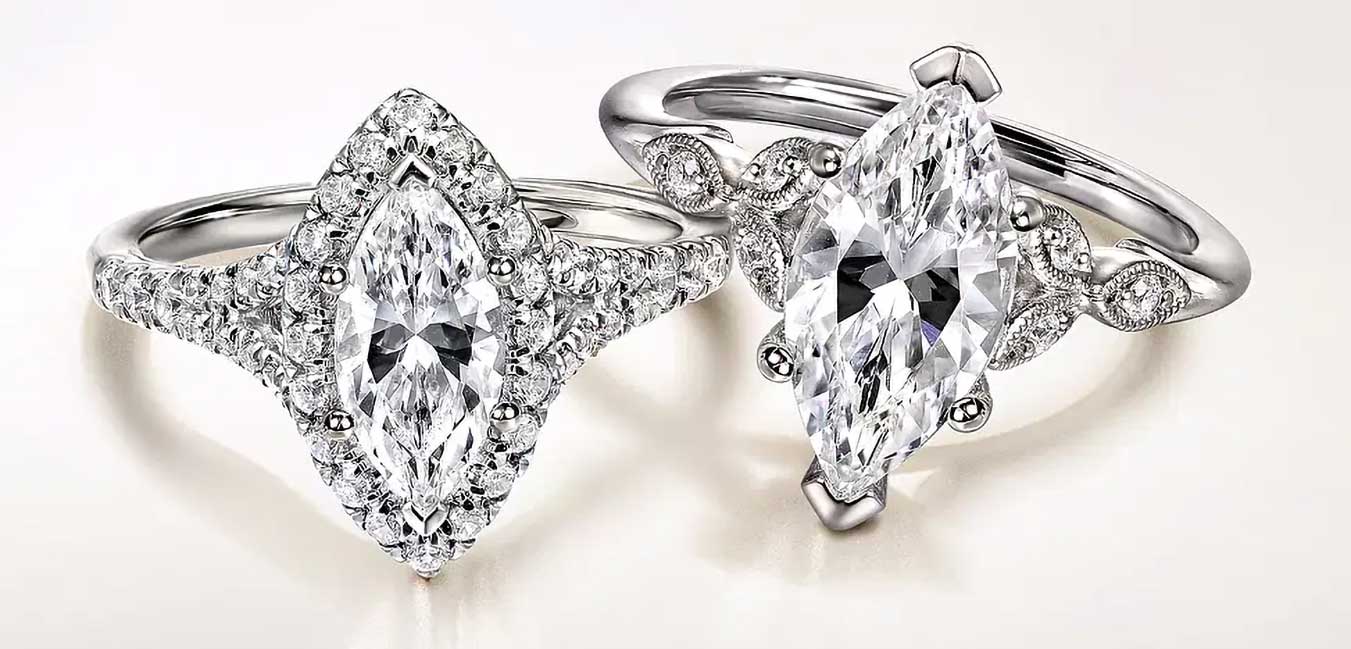The Marquise diamonds, with its striking elongated shape and sharp, regal points, has captivated the attention of jewelry lovers for centuries. Known for its distinctive boat-like or football-shaped silhouette, this diamond cut is synonymous with elegance, grace, and sophistication. Whether set in engagement rings, necklaces, or earrings, the Marquise diamond carries an aura of exclusivity and vintage charm. But what makes the Marquise so special? Let’s dive into its history, characteristics, and reasons why it continues to be a favorite among those who seek a unique yet classic diamond.
History of the Marquise Diamond
The Marquise diamond has a rich and somewhat romantic history. Legend has it that the Marquise cut was created in the 18th century during the reign of Louis XV of France. The story goes that the French king commissioned a jeweler to craft a diamond shape that resembled the smile of his mistress, Madame de Pompadour, or even the shape of her lips. The cut was initially designed to evoke elegance, allure, and beauty—qualities that perfectly matched the royal mistress.
The Marquise cut’s name itself is derived from the French word “marquise,” meaning “marchioness” or “noblewoman,” which speaks to its association with the aristocracy and high social class. In the 18th and 19th centuries, the Marquise diamond became popular among European aristocracy and royalty, symbolizing opulence and refinement. Over time, the cut evolved, and by the 20th century, it had secured its place in modern jewelry design.
Characteristics of the Marquise Diamond
A Marquise diamond is defined by its elongated shape with pointed ends, which gives it an appearance similar to a boat, leaf, or football. This unique shape not only makes it visually striking but also lends itself to a variety of creative settings and designs. Some of the key characteristics that define a Marquise diamond include:
Shape and Proportions
The Marquise cut is a modified brilliant cut, which means it contains a series of facets that help to maximize its brilliance and sparkle. However, its most distinctive feature is its elongated shape. The length-to-width ratio of a Marquise diamond can vary, with the most traditional proportions falling between 1.75:1 and 2.25:1. The longer the diamond, the more dramatic the visual effect.
The Marquise cut tends to appear larger than other cuts of the same carat weight due to its shape, which can give the illusion of a bigger diamond. This makes it an attractive choice for those looking to get a visually larger stone without the higher price tag of larger carat weight.
Facet Pattern
The Marquise diamond is cut with 56 to 58 facets, much like the round brilliant cut. These facets help the diamond reflect light from all angles, creating stunning brilliance. The sharp points at either end of the Marquise can, however, present a challenge when it comes to protecting the stone. The points are more prone to chipping or damage if they are not adequately safeguarded with prong settings or bezel settings.
Brilliance and Sparkle
Like other brilliant cuts, the Marquise diamond is designed to maximize light return, creating an exceptional amount of brilliance. Its elongated shape and carefully placed facets allow the light to bounce through the diamond, producing vivid sparkle. However, the “bow tie effect” is a well-known characteristic of Marquise diamonds—this phenomenon refers to the dark, bow-tie shaped area that can appear in the center of the diamond when light is not reflected optimally. While this effect is not universally desirable, a high-quality Marquise diamond with proper proportions will minimize this occurrence.
Why Choose a Marquise Diamond?
While the Marquise diamond may not be as widely recognized as the round brilliant or princess cut, it offers several compelling advantages that make it a standout choice for those looking for something unique. Here are some reasons why people opt for Marquise diamonds:
Visual Elongation
The most obvious benefit of a Marquise diamond is its ability to create the illusion of a larger stone. The elongated shape of the diamond can make fingers appear longer and more slender, which is particularly appealing in engagement rings. This elongation effect is also perfect for those who want a visually larger diamond without paying for the extra carat weight. The diamond’s shape can also complement oval or round stones in mixed stone designs.
Unique and Timeless
The Marquise cut stands out from the crowd. While round and square cuts dominate the diamond world, the Marquise offers something different. Its timeless elegance, combined with its history and association with royalty, gives the cut a sense of sophistication that few other shapes can match. The Marquise diamond remains a favorite for brides who desire something unconventional yet classic.
Great for Custom Designs
The unique shape of the Marquise diamond makes it ideal for custom jewelry designs. Its distinctive form allows it to be set in various ways—either horizontally or vertically—to suit the wearer’s preferences. It pairs beautifully with a wide range of other gemstones, whether in a multi-stone engagement ring or a vintage-inspired piece. The versatility of the Marquise shape makes it a go-to option for creating personalized, one-of-a-kind pieces.
Vintage Appeal
As a cut with a deep historical legacy, the Marquise diamond has an undeniable vintage appeal. While it’s not as commonly seen as other cuts, it evokes a sense of nostalgia and opulence, particularly for those who want a piece with a touch of old-world glamour. Its enduring popularity throughout history, from the time of Louis XV to the present, gives it a classic, timeless quality that never goes out of style.
Things to Consider When Buying a Marquise Diamond
When shopping for a Marquise diamond, there are several factors to consider to ensure that you get the best value and quality for your investment.
Cut and Proportions
The cut quality of a Marquise diamond is crucial in determining its brilliance and visual appeal. The length-to-width ratio plays a key role in the overall aesthetic of the diamond. While personal preference varies, many buyers prefer a Marquise diamond with a length-to-width ratio between 1.75:1 and 2.00:1, as it provides a balanced look. Proportions that are too narrow or too wide can affect the overall appearance of the stone and may cause issues with light reflection.
The Bow Tie Effect
The bow tie effect, while unavoidable, can vary in intensity. It’s important to select a Marquise diamond with well-proportioned facets and symmetry to minimize the occurrence of this dark shadow in the center of the diamond. A well-cut Marquise will have minimal bow tie visibility.
Protection of the Points
Due to the sharp, pointed ends of the Marquise diamond, it is important to ensure that the stone is set in a way that protects these vulnerable points. A bezel setting or a prong setting with extra care around the points can help shield the diamond from chips and damage.
Conclusion
The Marquise diamond is a stunning and sophisticated choice for those looking to make a bold statement. With its royal history, distinctive elongated shape, and brilliant sparkle, it remains a timeless favorite. Whether you are drawn to its unique appeal, its ability to create the illusion of size, or its vintage charm, the Marquise diamond is a perfect way to express your individuality and sense of style. Just as it did centuries ago, the Marquise continues to embody elegance, luxury, and enduring beauty in the world of fine jewelry.

